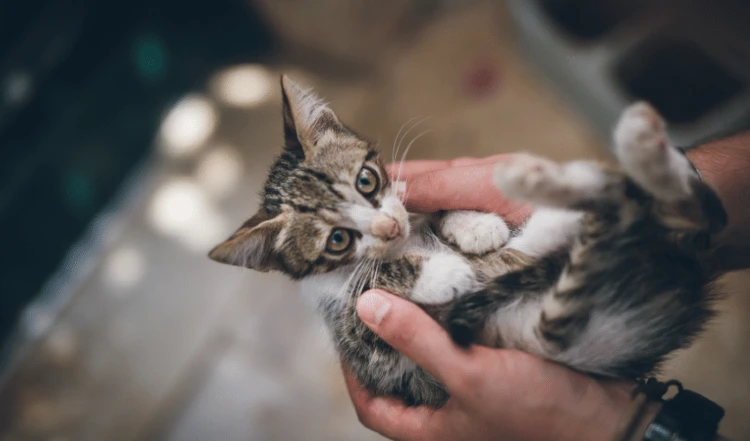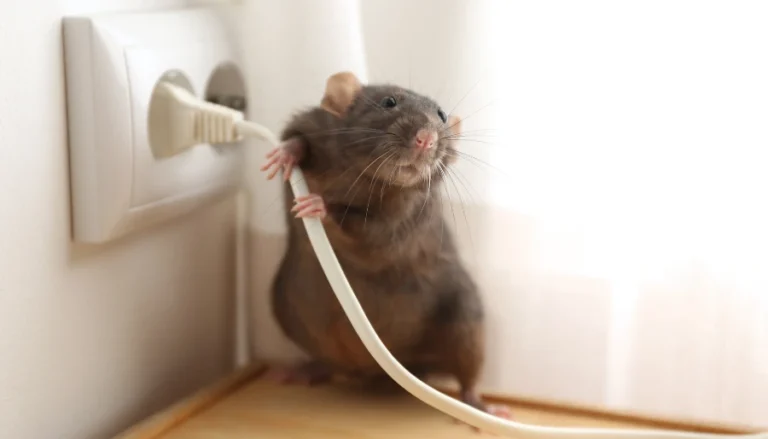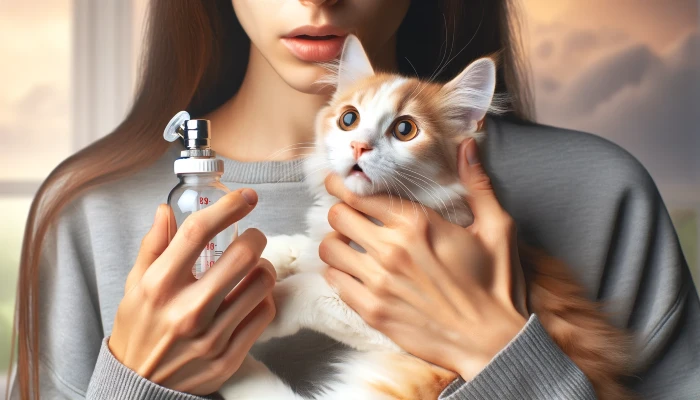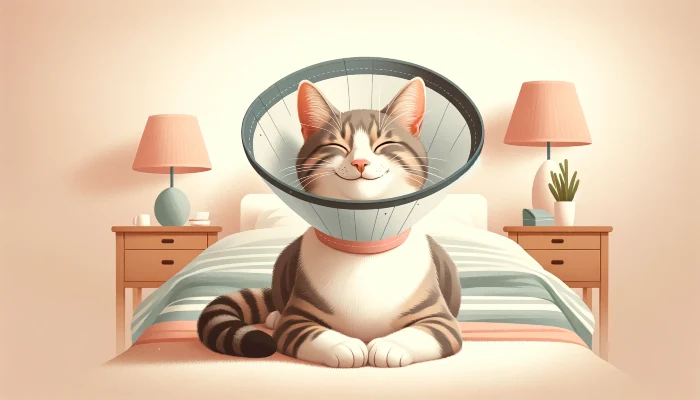Cats are fascinating, smart, beautiful animals, and they make amazing pets. Cats give you companionship, love, entertainment and happiness.
If you haven’t found your new cat or kitten yet, please consider adopting from your local Humane Society or Animal Shelter.
Using this guide will help you give your cat the care he needs to live a happy and healthy life.
Get the supplies you need for your new cat before you bring him home. I’ve included a list of supplies below. You’ll also need to check that your home is safe.
Here are a few things to check:
- Check all windows for missing or loose screens.
- Check all TV stands, bookcases and shelves to see if they are stable and can withstand a cat jumping or climbing on them.
- Check that all of your houseplants are safe for cats. A list of unsafe plants is provided below.
- Check the house (every floor) for any strings, yarn, rubber bands, dental floss and baggie ties. Cats will swallow these items, and they can cause serious and sometimes fatal damage to his digestive tract.
- Make sure all medications are kept in a bottle with a secure lid.
Litter: Open Box, Covered, or Robotic?
There are several types of litter boxes available. The basic open litter box, covered litter boxes and self-cleaning, robotic litter boxes. Any of these boxes will work, but there are benefits to using a covered box.
Covered boxes will keep the litter from being thrown all over the floor when your cat is covering his droppings, and they also are better at keeping odors contained.
Cat litter also comes in several varieties. Clay, scoopable, recycled newspaper pellets, and a few others.
The one you choose is a personal choice, but with experience, I have found a good scoopable litter makes keeping your cat’s box cleaner. Be sure to get a litter scoop that will work for the cat litter you choose.
You should clean any urine and droppings out of the box at least once a day. If you allow the box to become too soiled, your cat may refuse to use the box and resort to other locations to use the bathroom.
When cleaning the box, be sure to watch for any abnormal colored urine or loose droppings.

Feeding Your Feline
Feed your cat or kitten a premium-quality, nutritionally complete food. Never feed your cat dog food, it doesn’t supply your cat with the nutritional requirements he needs. There are both dry and canned varieties.
The amount you feed your cat depends on his age, activity level and health. You can follow the recommendations on the food label or consult your vet to get an amount that is appropriate for your cat.
When feeding canned foods, make sure you don’t leave it sitting out longer than 1/2 hour. Once you have an idea on how much your cat will eat at a sitting, place that amount in the bowl and cover and refrigerate the rest.
Kittens under one year of age should eat food made for kittens.
You can offer small amounts of safe people food to your cat as a treat (try to only keep it about 5% of his daily food intake). A list of safe and unsafe foods for your cat is provided below.
Water should be available at all times. The water bowl must be cleaned and changed daily. Cats prefer drinking fresh water.
Cats Are Naturally Clean Creatures, But...
While cats are pretty clean animals by nature, you’ll still have some responsibility. Regular brushing or combing, toenail trims and on a rare occasion, a bath is the only grooming you will need to do.
Brushing or combing your cat’s coat will help reduce shedding. Short coated cats should be brushed at least once a week and long coated breeds at least 2–3 times a week to control mats.
If the need to bathe your cat arises, try to get someone to help you. It is easier if one person holds the cat while the other does the bathing.
Most cats don’t like water, so having an extra set of hands is helpful.
Use a shampoo that is made for cats, and avoid getting water and soap in the eyes and ears.
Make sure to rinse your cat thoroughly to remove soap residue.
After bathing, wrap him in a towel and get as much excess water off, and then wrap in a dry towel to continue drying him. Be sure to keep your cat in a warm area until he is completely dry.
Give a quick brushing to get rid of loose hair.
Keeping your cat’s toenails trimmed is very important. They should be done at least once a month. If his nails are allowed to get too long, the nails can get caught in carpeting, upholstery and clothing.
You can learn to do this at home (there are some how-to videos on YouTube, including my personal favorite below) or you can ask a veterinarian or groomer how to do it for a small fee.
If you feel comfortable trimming your cat’s nails, use cat nail scissors. These are the best tool for cat toenail trims. They are easy to handle and allow you to see the nail during trimming.
You can either sit with your cat on your lap or put him on a table. Make sure you have plenty of light, apply gentle pressure to one nail to extend the nail and look for the quick (the pink vein that is in the nail) and just only trim the tip of the nail to avoid cutting into the quick. Repeat with all front nails.
If you do happen to nick the quick, use a paper towel to apply pressure or if you have it, apply a styptic powder. Keep pressure on the nail until the bleeding stops. The rear nails can be done the same way, but they don’t usually require trimming as often as the front nails.
About Your Cat's Health
Keeping your cat healthy will require you to take him to the vet at least once a year for a complete check-up and vaccines.
If you have a kitten, he will need to go to the vet every 3-4 weeks to receive his kitten vaccination series and wormings. It is important to develop a good relationship with your cat’s vet, so you can work together to keep your cat healthy.
Anytime you take your cat to the vet or away from home, make sure that he is always in a secure carrier. This will keep him safe and also prevent escape.
Vaccination Schedule
Kittens
-
- 6-7 weeks – FCRCPC 1st dose
- 10 weeks – FCRCPC 2nd dose
- 12 weeks – Rabies
- 13 weeks – FCRCPC 3rd dose
- 16-19 weeks – FCRCPC 4th dose
Adults
Annual boosters of FCRCPC and Rabies, as well as any other vaccines that have been given.

Spaying And Neutering
If you’re planning to be a responsible and loving cat owner, whether you spay or neuter your cat isn’t a question.
You must spay or neuter as this will help your cat live longer, reduce or eliminate some behavior issues (like spraying) and make him or her calmer.
Please do not put human issues or concerns on your feline.
-
- Cats do not have sex for pleasure.
- They do not reproduce because they desperately desire a family.
- They do not experience any emotions when engaging in sexual activity.
- Neutering your cat does not make them any less of a “man” – they are cats.

They reproduce because they have no choice. If you’re unclear what this means, look up videos of cat reproduction on YouTube. It’s not a pleasurable experience for them.
It’s best to spay/neuter before your kitten is 5 months old. You can have this done as early as 8 weeks as long as your kitten is in good health and meets the weight requirement.
Unspayed females don’t have a set heat cycle like dogs do. They go into heat several times a year. A female in heat is very vocal and loud, will put her rump in the air anytime someone touches her, and may try to escape to get to a male. She will also attract male cats to your door, and they will spray to make their presence known.
Unneutered males will spray urine everywhere to mark their territory, will escape to find females in heat (they can smell one for miles) and will fight with other cats.
The shelters and the streets are already full of the results of unwanted pregnancy.
Please help control the pet overpopulation problem, spay or neuter your cat!
When Scratching Is Life

Cats scratch. This is their nature. You can’t change it or alter this deeply rooted behavior. Scratching will happen.
Make sure that you provide your cat with a couple of scratching posts, or they’ll be more likely to use your furniture.
You have options! There are inexpensive corrugated cardboard types, carpeted types and some wrapped in sisal rope. Pick the option that you like and fits into your budget.
Place the scratch posts in a few areas around the house and show your cat where they are. Try sprinkling some catnip on the posts to attract your cat to the post (this most likely won’t work for kittens under 6 months old) and if you see him scratch at it, make sure you praise him a lot, so he gets the idea that scratching this is a good thing.
Collar And ID
Make sure your cat wears a collar (use only break away cat collars) and an ID tag with your current contact information whether your cat is indoors or outdoors.
I also highly recommended that you microchip your cat. This is a form of identification that can’t be removed or lost.
Fleas And Ticks
Keeping your cat free of fleas and ticks is critical to maintain his overall health.
Fleas and ticks spread diseases, which can cause illness or even death to your cat. The easiest way to do this is to use a product that you apply once a month. Be sure to only use a product made for cats. It’s also important to read the label and get one for your cat’s weight. Some are also not safe for a kitten under a certain age, so be careful.
It is recommended to always keep your cat indoors. Outdoor cats or the hybrid cat ownership model (indoor and outdoor) increases the chance of injury or death. If you want to take your cat outside, put him on a secure harness and leash and always stay with him. If a dangerous situation arises, you can quickly pick your cat up and take him indoors.
With your care and love, your cat can provide you with 16 or more years of love and companionship.

List of Supplies
-
- Premium-quality Cat or Kitten Food
- Food and Water Bowls
- Litter Box
- Litter Scoop
- Cat Litter
- Cat Carrier
- Brush or Comb
- Cat Nail Scissors
- Break Away Cat Collar and ID Tag
- Cat Bed or Soft Blanket
- Toys
Plants That Are Not Safe For Your Cat
-
- Aloe
- Asian Lily
- Asparagus Fern
- Begonia
- Bird of Paradise
- Branching Ivy
- Caladium
- Cutleaf Philodendron
- Cornstalk Plant
- Fig Tree
- Golden Birds Nest
- Pothos
- Jade Plant
- Lemon Tree
- Umbrella Plant
- Peace Lily
- Pencil Cactus
- Monstera Deliciosa
- Mother-in-Law’s Tongue
- Sago Palm
- English Ivy
- Dumb Cane
Safe Foods For Your Cat
-
- Cooked turkey, beef, chicken, pork, lamb, liver and fish. No bones & no fat!
- Cheese
- Fully cooked eggs
- Carrots
- Spinach
- Peas
- Pumpkin
- Cantaloupe
- Watermelon
- Blueberries
- Bananas
- Apples (no seeds)
- Whole Grains
- Plain Bread
Unsafe Foods For Your Cat
-
- Alcohol
- Chocolate
- Coffee and Caffeine
- Avocados
- Citrus
- Coconut and Coconut Oil
- Grapes and Raisins
- Nuts
- Macadamia Nuts
- Onions
- Garlic
- Chives
- Raw eggs
- Raw or undercooked meats(risk of salmonella)
- Salt and salty snacks
- Fatty Food
- Yeast Dough
- Any product containing Xylitol






















